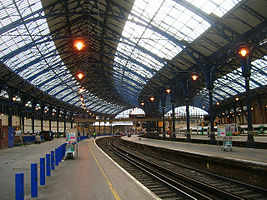Brighton Railway Station
| Brighton Railway Station | |
|---|---|
|
Brighton Railway Station
|
|
| Data | |
| Operating point type | Long-distance train station |
| Design | Terminus |
| Platform tracks | 8th |
| abbreviation | BTN |
| IBNR | 7000321 |
| opening | 1840 |
| Architectural data | |
| architect | David Mocatta |
| location | |
| City / municipality | Brighton |
| county | East Sussex |
| Part of the country | England |
| Country | United Kingdom |
| Coordinates | 50 ° 49 '44 " N , 0 ° 8' 28" W |
| Railway lines | |
| List of train stations in the United Kingdom | |
The Brighton train station is a rail transportation hub in Brighton , City of Brighton and Hove in East Sussex , England . The covered with a steel and glass hall railhead is located just north of downtown. The station is the terminus of the Brighton Main Line from London and the starting point of the West Coastway Line to Southampton / Portsmouth and the East Coastway Line to Seaford / Eastbourne - Hastings .
history
Brighton Station began operating in 1840 when the Brighton - Shoreham-by-Sea section of what is now the West Coastway Line , built by the London and Brighton Railway , opened. In addition to the passenger station, a freight station and a locomotive depot were also built.
In 1841 the Brighton Main Line and thus the direct train connection to London was completed with the gap between Brighton and Haywards Heath .
In 1846 the East Coastway Line was opened to St. Leonhards Marina West (part of Hastings ). In 1933 the Brighton Main Line and until 1937 also the coast lines were electrified with a side busbar.
buildings
The entrance building , which still exists today, was planned by the architect David Mocatta (1806–1882) in the style of the Italian Renaissance and opened in 1841 with the route to Shoreham.
In 1882/83 the station was expanded considerably. The imposing platform hall and the roofing of the station forecourt were built. In 1999/2000 the hall was thoroughly renovated and restored to its blue color.
The station has eight platform tracks on four central platforms. Between tracks 7 and 8 there is still the former "Cab Way", the taxi way that is no longer used. The former platform track 9 now only serves as a siding, the platform serves as a footpath connection outside the area separated by platform barriers. Until 1971 there were also two tracks 10 and 11 outside of today's platform hall, which had become superfluous with the closure of the short branch line to the Brighton district of Kemp Town.
In the triangle between the western coastline and the Brighton Main Line was the railway depot , a little further towards London the wagon plant, which is still in operation today.
East of the station was the locomotive factory of the Southern Railway and its predecessor companies from 1852 to 1958 . After a British license for the Isetta was manufactured in the halls for a few years , the plant was demolished in 1969 and the site was used as a parking lot. Since 2009 it has been redeveloped as the New England Quarter urban development project .
The freight yard , down the valley next to the station and the locomotive factory, was shut down in the 1980s. Some of it has already been rebuilt, and some of it is being developed as part of the New England Quarter project.
Railway facilities: on the left the western coastal line and the former steam locomotive depot, behind it today's railcar depot, in the middle the tracks to London, on the right the former locomotive factory, today the New England Quarter and behind it the London Road Viaduct of the eastern coastal line
Locomotive factory (photo from 1961 with the famous Brighton Belle electric pullman suit )
business
Societies
The station is served by the companies Southern , Gatwick Express , First Capital Connect and First Great Western .
The Cross Country introduced the end of 2008 their trains to Birmingham one which on the West London Line led.
Train connections
- Brighton - Gatwick Airport - London Victoria ( Southern )
- Brighton - Gatwick Airport - London Bridge - Snow Hill Tunnel - London St Pancras - Bedford ( First Capital Connect as Thameslink )
- Gatwick Express to Gatwick Airport - London Victoria (peak hours only)
- Brighton - West Worthing ( Southern )
- Brighton - Hove ( Southern )
- Brighton - Southampton Central ( Southern )
- Brighton - Portsmouth & Southsea - Portsmouth Harbor ( Southern )
- Brighton - Worcester Hill Shrub / Great Malven ( First Great Western )
- Brighton - Newhaven - Seaford ( Southern )
- Brighton - Lewes ( Southern )
- Brighton - Lewes - Eastbourne - Hastings - Ore (- Ashford International ) (Southern)
West Coastway Line and East Coastway Line trains to / from London bypass Brighton Station.
Web links
Individual evidence
- ↑ http://spartacus-educational.com/RAbrightonST.htm
- ^ New England Quarter on the City of Brighton and Hove website







